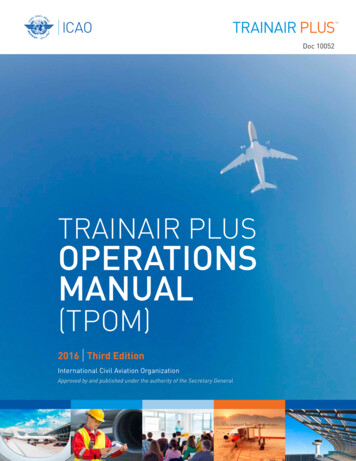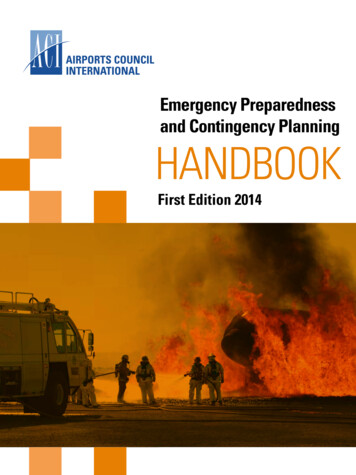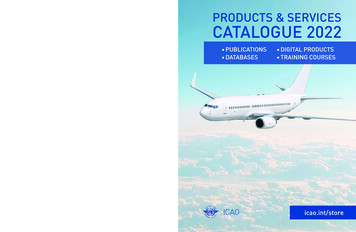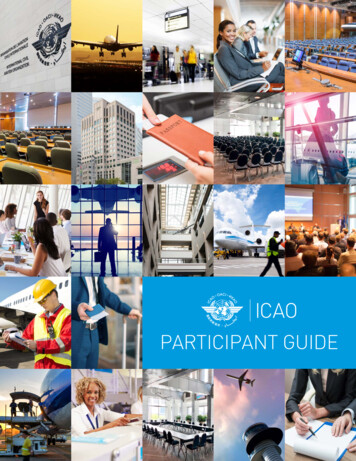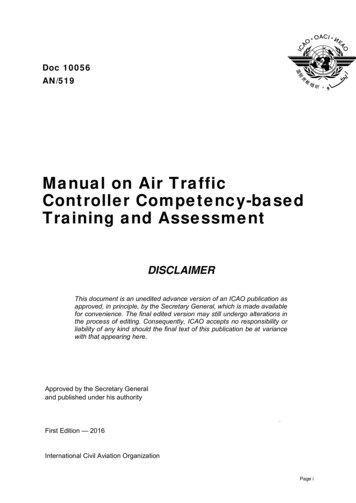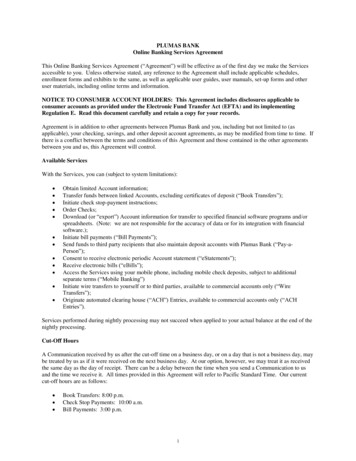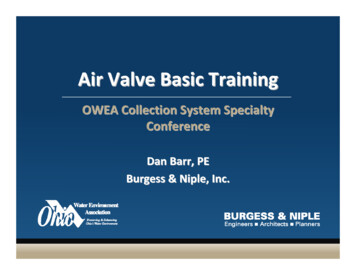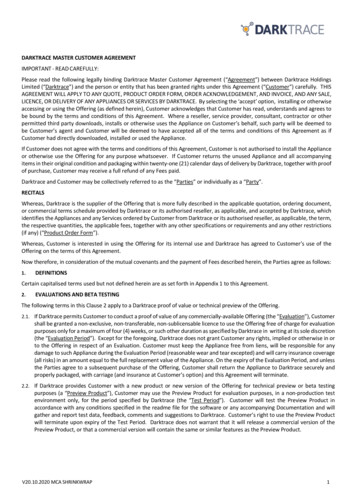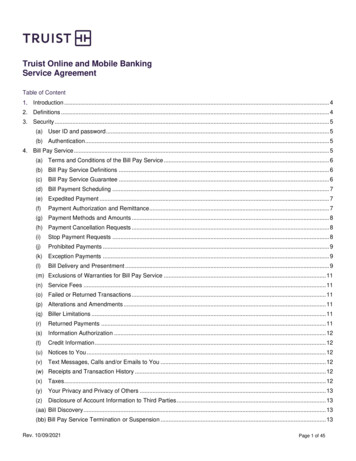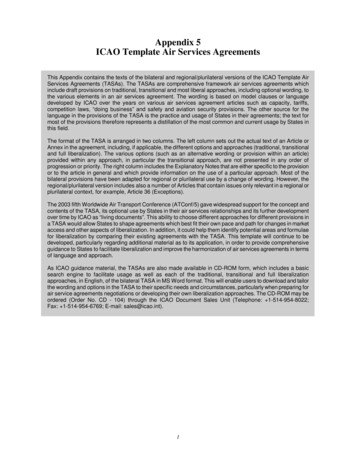
Transcription
Appendix 5ICAO Template Air Services AgreementsThis Appendix contains the texts of the bilateral and regional/plurilateral versions of the ICAO Template AirServices Agreements (TASAs). The TASAs are comprehensive framework air services agreements whichinclude draft provisions on traditional, transitional and most liberal approaches, including optional wording, tothe various elements in an air services agreement. The wording is based on model clauses or languagedeveloped by ICAO over the years on various air services agreement articles such as capacity, tariffs,competition laws, “doing business” and safety and aviation security provisions. The other source for thelanguage in the provisions of the TASA is the practice and usage of States in their agreements; the text formost of the provisions therefore represents a distillation of the most common and current usage by States inthis field.The format of the TASA is arranged in two columns. The left column sets out the actual text of an Article orAnnex in the agreement, including, if applicable, the different options and approaches (traditional, transitionaland full liberalization). The various options (such as an alternative wording or provision within an article)provided within any approach, in particular the transitional approach, are not presented in any order ofprogression or priority. The right column includes the Explanatory Notes that are either specific to the provisionor to the article in general and which provide information on the use of a particular approach. Most of thebilateral provisions have been adapted for regional or plurilateral use by a change of wording. However, theregional/plurilateral version includes also a number of Articles that contain issues only relevant in a regional orplurilateral context, for example, Article 36 (Exceptions).The 2003 fifth Worldwide Air Transport Conference (ATConf/5) gave widespread support for the concept andcontents of the TASA, its optional use by States in their air services relationships and its further developmentover time by ICAO as “living documents”. This ability to choose different approaches for different provisions ina TASA would allow States to shape agreements which best fit their own pace and path for changes in marketaccess and other aspects of liberalization. In addition, it could help them identify potential areas and formulaefor liberalization by comparing their existing agreements with the TASA. This template will continue to bedeveloped, particularly regarding additional material as to its application, in order to provide comprehensiveguidance to States to facilitate liberalization and improve the harmonization of air services agreements in termsof language and approach.As ICAO guidance material, the TASAs are also made available in CD-ROM form, which includes a basicsearch engine to facilitate usage as well as each of the traditional, transitional and full liberalizationapproaches, in English, of the bilateral TASA in MS Word format. This will enable users to download and tailorthe wording and options in the TASA to their specific needs and circumstances, particularly when preparing forair service agreements negotiations or developing their own liberalization approaches. The CD-ROM may beordered (Order No. CD - 104) through the ICAO Document Sales Unit (Telephone: 1-514-954-8022;Fax: 1-514-954-6769; E-mail: sales@icao.int).1
2BILATERAL TEMPLATE AIR SERVICES AGREEMENTThroughout this document:1) an asterisk is used to indicate that a specific provisionwithin an article is common to each of the traditional,transitional and full liberalization approaches. No asteriskappears if the whole article applies to all three approaches.However in some articles, such as “Designation andauthorization”, the provision is reproduced in full for eachapproach for purposes of readability and clarity of theArticle;2) in an article which provides for more than one approach,i.e. traditional, transitional, full liberalization, the samesequential order of presentation is maintained down thepage, for ease of readability;3) similarly, where there are options within an approach(for example, two options within the transitional approach)these are also provided separately, but not in any order ofpriority.
3Table of ContentsPreamble .Page3Article 1Article 2Article 3Article 4Article 5Article 6Article 7Article 8Article 9Article 10Article 11Article 12Article 13Article 14Article 15Article 16Article 17Article 18Article 19Article 20Article 21Article 22Article 23Article 24Article 25Article 26Article 27Article 28Article 29Article 30Article 31Article 32Article 33Article 34Article 35Article 36Article 37Article 38Article 39Definitions .Grant of rights .Designation and authorization .Withholding, revocation and limitation of authorization .Application of laws .Direct transit .Recognition of certificates .Safety .Aviation security .Security of travel documents .Inadmissible and undocumented passengers and deportees .User charges .Custom duties .Taxation .Fair competition .Capacity .Pricing (Tariffs) .Safeguards .Competition laws .Currency conversion and remittance of earnings .Sale and marketing of air service products .Non-national personnel and access to local services .Change of gauge .Ground handling .Codesharing/Cooperative arrangements .Leasing .Intermodal services .Computer reservations systems (CRS) .Ban on smoking .Environmental protection .Statistics .Approval of schedules .Consultations .Settlement of disputes .Amendments .Multilateral agreements .Termination .Registration with ICAO .Entry into force 66676869707172738182838485Annex IAnnex IIAnnex IIIAnnex IVAnnex VRoute schedules .Non-scheduled/Charter operations .Air cargo services .Transitional measures .Essential Service and Tourism Development Routes .8689949699
4Preamble[Option 1 of 2]The Government of . and the Government of .hereinafter referred to as the “Parties”;The initial part of the agreement presents the reasonfor entering into the agreement and declares thatthey have agreed to what will follow in subsequentparts of the agreement.Being parties to the Convention on InternationalCivil Aviation, opened for signature at Chicago on7 December 1944;Desiring to contribute to the progress ofinternational civil aviation;Desiring to conclude an agreement for the purposeof establishing and operating air services betweenand beyond their respective territories;Have agreed as follows:[Option 2 of 2]The Government of . and the Government of.(hereinafter, “the Parties”);Being Parties to the Convention on InternationalCivil Aviation, opened for signature at Chicago on7 December, 1944;Desiring to promote an international aviation systembased on competition among airlines in themarketplace with minimum government interferenceand regulation;Desiring to facilitate the expansion of internationalair services opportunities;Recognising that efficient and competitiveinternational air services enhance trade, the welfareof consumers, and economic growth;This approach is common in more liberalagreements and the bracketed text is common to“open skies”agreements.
5Preamble (cont’d)[Option 2 of 2] (cont’d)Desiring to make it possible for airlines to offer thetravelling and shipping public a variety of serviceoptions [at the lowest prices that are notdiscriminatory and do not represent abuse of adominant position], and wishing to encourageindividual airlines to develop and implementinnovative and competitive prices; andDesiring to ensure the highest degree of safety andsecurity in international air services and reaffirmingtheir grave concern about acts or threats against thesecurity of aircraft, which jeopardise the safety ofpersons or property, adversely affect the operation ofair services, and undermine public confidence in thesafety of civil aviation.Have agreed as follows:
6Article 1DefinitionsFor the purposes of this Agreement, unless otherwisestated, the term:While the Parties to an air services agreement maychoose to define any number of terms used in theiragreement, for the purposes of clarity or in the eventof any possible ambiguity, the foregoing are theterms that may be commonly found in a Definitionsarticle.a) “air transportation” means the public carriage byaircraft of passengers, baggage, cargo and mail,separately or in combination, for remuneration orhire;b) “aeronautical authorities” means, in the case ofthe ; in the case of the ; or in both cases anyother authority or person empowered to perform thefunctions now exercised by the said authorities;c) “Agreement” means this Agreement, its Annex,and any amendments thereto;d) “capacity” is the amount(s) of services providedunder the agreement, usually measured in thenumber of flights (frequencies) or seats or tons ofcargo offered in a market (city pair, orcountry-to-country) or on a route during a specificperiod, such as daily, weekly, seasonally or annually;e) “Convention” means the Convention onInternational Civil Aviation opened for signature atChicago on the seventh day of December, 1944, andincludes any Annex adopted under Article 90 of thatConvention, and any amendment of the Annexes orConvention under Articles 90 and 94, insofar assuch Annexes and amendments have becomeeffective for both Parties;f) “designated airline” means an airline which hasbeen designated and authorized in accordance withArticle of this Agreement;g) “domestic air transportation” is air transportationin which passengers, baggage, cargo and mail whichare taken on board in a States territory are destinedto another point in that same State’s territory;h) “ICAO” means the International Civil AviationOrganization;For “aeronautical authorities” the requiredinsertions will depend on the prevailingadministrative structures and arrangements in placein each Party.
7Article 1Definitions (cont’d)i) “intermodal air transportation” means the publiccarriage by aircraft and by one or more surfacemodes of transport of passengers, baggage, cargoand mail, separately or in combination, forremuneration or hire;j) “international air transportation” is airtransportation in which the passengers, baggage,cargo and mail which are taken on board in theterritory of one State are destined to another State;k) “Party” is a State which has formally agreed tobe bound by this agreement;l) [“price”] or [“tariff”] means any fare, rate orcharge for the carriage of passengers, baggageand/or cargo (excluding mail) in air transportation(including any other mode of transportation inconnection therewith) charged by airlines, includingtheir agents, and the conditions governing theavailability of such fare, rate or charge;Although the broader and more modern term“price” is used rather than “tariff”; the definition isessentially the same for both terms.m) “territory” in relation to a State [means the landareas and territorial waters adjacent thereto and theairspace above them under the sovereignty of thatState] has the meaning assigned to it in Article 2 ofthe Convention;For the term “territory” there are two possible waysto define it, one by reference to the definition of thatword in Article 2 of the Convention, and the otherspelling out the usual meaning attributed to it ininternational law and practice. Both are presentedas alternative language.n) “user charges” means a charge made to airlinesby the competent authorities, or permitted by them tobe made, for the provision of airport property orfacilities or of air navigation facilities, or aviationsecurity facilities or services, including relatedservices and facilities, for aircraft, their crews,passengers and cargo; ando) “air service”, “international air service”,“airline”, and “stop for non-traffic purposes”, havethe meanings assigned to them in Article 96 of theConvention.
8Article 2Grant of rights1.* Each Party grants to the other Party the rightsspecified in this Agreement for the purpose ofoperating international air services on the routesspecified in the Route Schedule.The Grant of rights provision sets out both thetraffic and non-traffic rights the Parties grant toeach other and usually needs to be read inconjunction with a schedule or annex that sets outthe routes, rights and any applicable conditions.2.* Subject to the provisions of this Agreement, theairline(s) designated by each Party shall enjoy thefollowing rights:The foregoing first two freedoms of the air,although included in multilateral agreements (forscheduled services, the International Air ServicesTransit Agreement (IASTA); for non-scheduledservices, Article 5 of the Convention), are teral agreements, either becausesome States may not be, or may cease to be,parties to the IASTA.a)* the right to fly without landing across the territoryof the other Party;b)* the right to make stops in the territory of the otherParty for non-traffic purposes;Traditionalc) the right to make stops at the point(s) on theroute(s) specified in the Route Schedule to thisAgreement for the purpose of taking on board anddischarging international traffic in passengers, cargoand mail [separately or in combination].This provision exchanges the other traffic rights onthe basis of the Route schedule. It is not necessaryto distinguish among the Third, Fourth and FifthFreedoms in the Grant of rights Article since theRoute schedule will establish the routes and pointsfor which the specific freedoms apply. One phrase“separately or in combination” is bracketed asbeing optional since its insertion would enable theoperation of all-cargo services. However, thesecould also be the subject of separate treatment andnegotiation between the Parties, includingspecified routes.Transitional and Full liberalizationc) the rights otherwise specified in this Agreement.*3. The airlines of each Party, other than thosedesignated under Article (Designation) of thisAgreement, shall also enjoy the rights specified inparagraphs 2 a) and b) of this Article.Traffic rights in liberal agreements are exchangedusing this formulation, in particular, “open skies”agreements. The Route schedule will, by itspresentation and wording, establish the various“freedoms of the air” as well as the routes whichmay specify points to be exchanged.The use of the term “airlines of each Party”includes both airlines which are designated andthose which are not.Traditional and Transitional4.Nothing in paragraph 2 shall be deemed toconfer on the designated airline(s) of one Party theprivilege of taking on board, in the territory of theother Party, passengers, cargo and mail forremuneration and destined for another point in theterritory of the other Party.A standard provision that excludes cabotageoperations from the grant of rights. Under fullliberalization where cabotage rights have beenexchanged, this is usually covered in the context ofthe Route schedule.
9Article 3Designation and authorizationThe formulation of the Designation andauthorization provision may be simplified byaddressing the reasons in paragraph 2 for a State toreceive an authorization in the Revocation ofauthorization Article, since the conditions for notgranting an authorization are the same.Traditional1. Each Party shall have the right to designate inwriting to the other Party an airline to operate theagreed services [in accordance with this Agreement]and to withdraw or alter such designation.The traditional approach refers to one airline or asingle designation.*2. On receipt of such a designation, and ofapplication from the designated airline, in the formand manner prescribed for operating authorization[and technical permission], each Party shall grant theappropriate operating authorization with minimumprocedural delay, provided that:a) substantial ownership and effective control arevested in the Party designating the airline, nationalsof that Party, or both;The traditional “substantial ownership and effectivecontrol” formula is still used in the majority ofbilateral agreements. The phrase is not defined andthe authorizing Party is the sole judge of whetherthe ownership and control criteria have been met.Nevertheless, “substantial ownership” is broadlyconsidered to mean more than 50 per cent equityownership. On the other hand, States take varyingviews in their domestic legislation or practice as towhat might constitute “effective control”. With thetraditional clause, there have been individualinstances where the authorizing Party has waived itsright to require that the ownership and controlcriteria be met.For a Party which receives the designation, it wouldretain the discretionary right of refusal as ameasure of control to address legitimate concerns ifand when required. This provision addressespotential concerns such as safety, security or othereconomic aspects including potential emergence of“flags of convenience”.
10Article 3Designation and authorization (cont’d)Traditional (cont’d)3. On receipt of the operating authorization ofparagraph 2, a designated airline may at any timebegin to operate the agreed services for which it is sodesignated, provided that the airline complies withthe applicable provisions of this Agreement.*Transitional1. Each Party shall have the right to designate inwriting to the other Party one or more airlines tooperate the agreed services [in accordance with thisAgreement] and to withdraw or alter suchdesignation.The transitional approach refers to one or moreairlines or multiple designation. The phrasing wassometimes interpreted as being met by thedesignation of two airlines. The transitionalapproach also includes formulae for increasing thenumber of designated airlines on specific routesbased on, for example, negotiated multi-yearincreases or the achievement of a specified level ofpassenger traffic in city-pair markets.2. On receipt of such a designation, and ofapplication from the designated airline, in the formand manner prescribed for operating authorization[and technical permission], each Party shall grant theappropriate operating authorization with minimumprocedural delay, provided that:[Sub-paragraphs 2a) through 2 c)*,option 1 of 2]a) the airline is and remains substantially ownedand effectively controlled by nationals of any one ormore States in a group, or by any one or more of theParties themselves;This approach uses the recommendation of the 1994World-wide Air Transport Conference (ATConf/4)which refers to an airline which is and remainssubstantially owned and effectively controlled bynationals of one or more States that are notnecessarily party to the agreement concerned butare within a predefined group with a “community ofinterest”. A second group formulation by ATConf/4is an airline which is substantially owned andeffectively controlled by nationals of any one ormore States that are parties to an agreement, or anyone or more of the parties themselves. The definitionof a European Union (EU) air carrier is an exampleof this ownership and control within a group (theEU criteria also includes principal place of businessand administrative headquarters in a MemberState).
11Article 3Designation and authorization (cont’d)Transitional (cont’d)*b) the Party designating the airline is in compliancewith the provisions set forth in Article (Safety) andArticle (Aviation Security); and*c) the designated airline is qualified to meet otherconditions prescribed under the laws and regulationsnormally applied to the operation of international airtransport services by the Party receiving thedesignation.[Sub-paragraphs a) through d)*, option 2of 2]a) the designated airline has its principal place ofbusiness (see (i) below) [and permanent residence]in the territory of the designating Party;b) the Party designating the airline has andmaintains effective regulatory control (see(ii) below) of the airline;Notes: —(i)evidence of principal place of businessincludes such factors as: the airline is establishedand incorporated in the territory of the designatingParty in accordance with relevant national laws andregulations, has a substantial amount of itsoperations and capital investment in physicalfacilities in the territory of the designating Party,pays income tax, registers and bases its aircraft there,and employs a significant number of nationals inmanagerial, technical and operational positions.In agreements where a reference is made toownership by nationals within a group of States, forexample, Member States within the EuropeanUnion, the text would be modified to take intoconsideration any changes in the EuropeanCommunity legislation.This approach recommended by ICAO would enablea State to designate air carriers as it sees qualified(including those with majority national ownership)to use and benefit from its entitled market accessrights under a bilateral agreement. At the sametime, it would reinforce the obligation on the part ofthe designating party to maintain effectiveregulatory control (including safety and securityoversight) over the airline it designates. Suchcontrol is envisioned primarily through licensingwhich can include both economic and operationalelements. The arrangement would not require theState to change its existing laws, policies orregulations pertaining to national ownership andcontrol of its own national air carrier(s), but wouldallow such change if and when the State wishes todo so.
12Article 3Designation and authorization (cont’d)Transitional (cont’d)[Sub-paragraphs a) through d)*, option 2of 2]*3. On receipt of the operating authorization ofparagraph 2, a designated airline may at any timebegin to operate the agreed services for which it is sodesignated, provided that the airline complies withthe applicable provisions of this Agreement.Full liberalization1. Each Party shall have the right to designate inwriting to the other Party as many airlines as itwishes to operate the agreed services [in accordancewith this Agreement] and to withdraw or alter suchdesignation.The full liberalization approach refers to as manyairlines or no quantitative limit on the number ofairlines which can be designated.*2. On receipt of such a designation, and ofapplication from the designated airline, in the formand manner prescribed for operating authorization[and technical permission], each Party shall grant theappropriate operating authorization with minimumprocedural delay, provided that:a) the airline is under the effective regulatory Full liberalization removes all criteria pertaining tocontrol of the designating State;the airline, but requires effective regulatory controlby the designating State to ensure compliance withSafety and Security standards. It would also includea “right of establishment” that is a right fornon-nationals to establish and operate an airline inthe territory of a Party which could then engage indomestic and international air services.*b)the Party designating the airline is incompliance with the provisions set forth in Article(Safety) and Article (Aviation Security); and*c) the designated airline is qualified to meet otherconditions prescribed under the laws and regulationsnormally applied to the operation of international airtransport services by the Party receiving thedesignation.
13Article 3Designation and authorization (cont’d)Full liberalization (cont’d)*3. On receipt of the operating authorization ofparagraph 2, a designated airline may at any timebegin to operate the agreed services for which it is sodesignated, provided that the airline complies withthe applicable provisions of this Agreement.Article 4Withholding, revocation and limitation ofauthorization*1. The aeronautical authorities of each Party shallhave the right to withhold the authorizations referredto in Article (Authorization) of this Agreement withrespect to an airline designated by the other Party,and to revoke, suspend or impose conditions on suchauthorizations, temporarily or permanently:The reasons for a State that receives a request foran authorization to not authorize initially or tosubsequently revoke, suspend or condition anauthorization it has granted are the same.Consequently, if the criteria for designation requiressuch formulation as “substantial ownership andeffective control” or “principal place of business”,then the failure to meet that requirement will begrounds for revocation, suspension or theimposition of conditions on the operatingpermission.Traditionala) in the event that they are not satisfied thatsubstantial ownership and effective control arevested in the Party designating the airline, nationalsof that Party, or both;*b) in the event of failure of the Party designatingthe airline to comply with the provisions set forth inArticle (Safety) and Article (Aviation Security);and*c) in the event of failure that such designatedairline is qualified to meet other conditionsprescribed under the laws and regulations normallyapplied to the operation of international air transportservices by the Party receiving the designation.Other bases for revocation are broader in scope andare covered by cross reference to the requirementsto comply with the provisions on safety, security andthe laws and regulations of that Party.
14Article 4Withholding, revocation and limitation ofauthorization (cont’d)Transitional[Sub-paragraphs a) through c)*, option 1of 2]a) in the event that they are not satisfied that theairline is and remains substantially owned andeffectively controlled by nationals of any one ormore States in a group, or by any one or more of theParties themselves;*b) in the event of failure of the Party designatingthe airline to comply with the provisions set forth inArticle (Safety) and Article (Aviation Security);and*c) in the event of failure that such designatedairline is qualified to meet other conditionsprescribed und
air service agreements negotiations or developing their own liberalization approaches. The CD-ROM may be ordered (Order No. CD - 104) through the ICAO Document Sales Unit (Telephone: 1-514-954-8022; Fax: 1-514-954-6769; E-mail: sales@icao.int). 2 BILATERAL TEMPLATE AIR SERVICES AGREEMENT .
